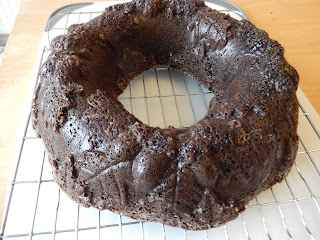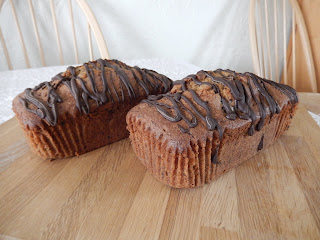Just before Christmas, I bought a jar of Christmas Cranberry Curd; just after Christmas I bought another - 'reduced to clear' so that the supermarket could get rid of unsold Christmas stock. I didn't have a clear idea of what to do with them at the time, but the idea of using some in a Bakewell tart type of thing slowly took shape. So, in my first baking session since Christmas, that's what I made.
I didn't have enough ground almonds, but I did have ground hazelnuts which needed using. I thought the hazelnut flavour might be better with cranberry, as it's much stronger than the flavour of almonds (in fact, you really need to add almond extract if you want a strong almond flavour in anything).
I also had some Trex cooking fat in the fridge, which needed using up too. I've never used Trex in baking (it was bought to make a lining paste for bundt tins) but it was past it's BBE date, so needed to be used. I did taste it to make sure it wasn't rancid, and it was fine. I substituted 1/4 of the butter in the pastry with Trex and just that amount was enough to make the pastry shorter than usual. The pastry dough seemed a little more difficult to work with, but it was worth it for the result, and didn't seem to affect the flavour greatly.
Ingredients
- Shallow 24cm tart/flan tin lined with chilled raw shortcrust pastry - no need to bake blind.*
- 200g of cranberry curd (lemon curd or a jam of your choice can be used instead)
- Frangipane - 100g softened butter, 100g caster sugar, 2 large eggs, 50g ground roasted hazelnuts, 25g ground almonds, 25g flour (I used SR flour, but think plain flour, or more nuts would be better **).
- 2 tablespoon of chopped roasted hazelnuts.
Method
Spread the cranberry curd over the base of the pastry case and return to the fridge while the frangipane is made.
Pre-heat oven to 200C/180C fan-assisted. Put a baking sheet in to heat up.
Make the frangipane by putting all the ingredients, except the chopped hazelnuts, into a bowl and beating until the mixture is light and fluffy and no specks of butter can be seen. Spread carefully over into the pastry case - I spoon small amounts of batter around the edge of the case then spread it inwards, so as not to move the curd or jam towards the edges of the pastry case, where it might erupt out of any gaps between the frangipane and pastry.
Use a teaspoon or a damp finger to try and seal the frangipane batter against the pastry sides, level the surface, then sprinkle over the chopped hazelnuts.
Transfer the tart to the heated baking sheet and bake at 200C for 10 minutes. Reduce the heat to 170C and bake for roughly another 25 minutes, until the frangipane isn't wobbling, and is golden brown in colour.
* I made shortcrust pastry using 300g flour, 150g butter and Trex and water to mix to a dough. I wanted some pastry for something else, so made more than necessary for one tart case. I'm guessing starting with 200g flour would be enough for just the tart case, and you could make a sweet shortcrust (adding sugar and egg) if preferred.
** The tart puffed up while baking, which I expected, as I'd added some SR flour, but it didn't sink evenly when it cooled, leaving a puffy rim around the edge of the tart and a fragile crust on the frangipane. This hasn't happened to me before, but I'm now rethinking the use of SR flour in frangipane. I'll try plain flour next time, but all ground nuts can be used too; I like a little flour as it makes the frangipane lighter and more cakey than when just nuts are used, but that's a personal preference.
This tart was absolutely delicious. The tartness of the cranberry curd stood up well to the flavour of the hazelnuts. My only disappointment was that the curd seemed to be absorbed into the bottom of the frangipane mixture, so that there wasn't a well defined layer of curd left after baking, as there usually is with jam. When I checked the curd ingredients, I noticed that it contained agar as a gelling agent, which gave it a strange gloopy consistency, but may also explain the way it behaved in the tart, when heated. Fortunately, this didn't affect the flavour, only the looks.
















